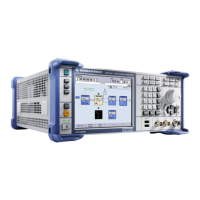Preparing for Use
R&S
®
SMBV100A
38Operating Manual 1407.6062.32 ─ 08
The configuration of the operating system is optimally adapted to signal generator func-
tions in the factory. Changes in the system setup are only required when peripherals like
keyboard are installed or if the network configuration does not comply with the default
settings (see chapter 2.6.1, "Connecting the Instrument to the Network", on page 39).
After the R&S SMBV is started, the operating system boots and the instrument firmware
is started automatically.
Accessing Operating System
The operating system cannot be accessed.
All necessary system settings can be made in the "Setup" dialog.
The R&S SMBV provides an internal flash memory and a hard disk (R&S SMBV-B92).
Both, the internal flash memory and the hard disk can be used to store data but the
firmaware is always hold on the internal flash card. However, data transfer is only possible
via a memory stick connected to a USB interface. The memory stick, the hard disk and
the flash memory are accessed via the "File Manager".
Accsessing the File System
The instrument also supports two standard methods to access the file system form a
remote client:
●
FTP (file transfer protocol)
●
File sharing according to the SAMBA/SMB (server message block) protocol.
Both methods allow the access to the folder /var/user/share.
Default password
The FTP and SAMBA file access use the user "instrument" with default password "instru-
ment".
In is highly recomended to change this password in the Setup > Security > Change User
Password dialog before connecting the instrument to the network!
Screen saver
A screen saver can be activated in the R&S SMBV. When active, the display is shut off
when no entries via front panel, external mouse or external keyboard are made for a
period of time. The screen saver prolongs the life time of the display.
Use the "Setup > Display Settings" dialog to switch on or off the screen saver and to
adjust the screen saver settings.
2.6 Setting Up a Network (LAN) Connection
The R&S SMBV is equipped with a network interface and can be connected to an Ethernet
LAN (local area network). Provided the appropriate rights have been assigned by the
Setting Up a Network (LAN) Connection

